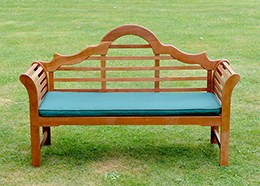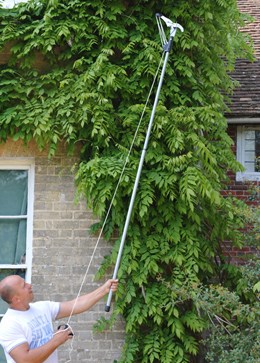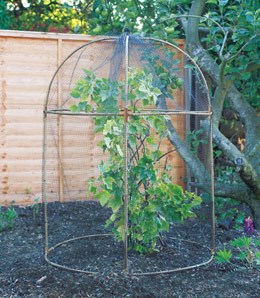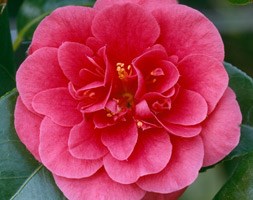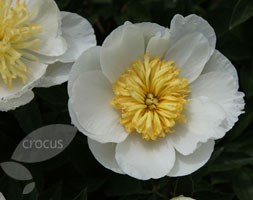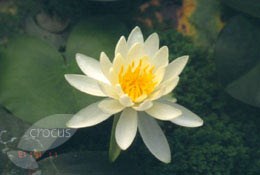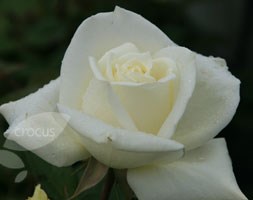New products at Crocus
by Sarah - July 19th, 2013.Filed under: Crocus, New Products.
Crocus just added loads of new lines
Lutyens bench cushion £36.99
For those of you that want a bit of extra comfort while sitting on your Lutyens bench, this box-shaped, bottle green cushion has plenty of polyester padding, giving it a generous 6cm thickness. Its zipped cover is easy to remove when it needs cleaning, is made from 100% cotton, and is finished with a smart piped edging. Dimensions: 128cm long x 50cm wide x 6cm thick The filling material and covering fabric meets the requirements for resistance to cigarette and match ignition as laid out in the Furniture and Furnishing (Fire) (Safety) Regulations 1988.
Fiskars dutch hoe £34.99
Ideal for cultivating and weeding. Features Stainless Steel heads enter soil more easily and help prevent rust Extra thick rubber-coated shaft and Softgrip handle for added grip Hanging hole for convenient storage
Fiskars telescopic tree pruner £24.99
This telescopic tree pruner is a multi-use tool with excellent accessibility to tree crowns and dense bushes. Trim overhead without a ladder or at ground level without bending or kneeling. Activate the great cutting power with a mere slide of the orange handle or when used at maximum height, pull the orange end knob. When you need to reach higher branches, try the telescopic version. The adjustable head and the light cutting mechanism ensures fast, easy and safe pruning. Features An asdjustable head for different cutting angles An anvil head with carbon steel blades for extra strength Will cut stems or branches up to 32mm diameter 30cm (12″) pruning saw included for cutting large branches Handle length of 1.25m handle extending to 2.4m (plus the head length on top this will give a total reach height of approx 2.7m)
Round fruit cage £22.99
Ideal for protecting young blackcurrant, blueberry, redcurrant and cranberry bushes, as well as many other ornamental and edible plants, from birds and animals, this round fruit cage also looks pretty smart. In winter you could also cover it with fleece (which is not included) to offer protection from the frosts. The kit comes with all the bamboo canes you need (these have been preserved naturally and treated with Tung oil), flexible and long-lasting joints, strong 15mm polyethylene mesh and 8 galvanised steel pegs for securing the frame and netting. Measurements: Height 1.5m (4ft 9in) x 1m (3ft 2in)
Camellia japonica ‘Lady Campbell’ (camellia) £19.99
Position: partial shade (but not east-facing) Soil: moist but well-drained, humus-rich, acid soil (or ericaceous compost for container-grown specimens) Rate of growth: average Flowering period: January to March Hardiness: fully hardy Double red flowers smother this compact, upright shrub. Garden care: To prevent damage to the emerg ing buds and flowers protect from cold, dry winds and early morning sun. Water e stablished plants in dry weather to prevent bud drop. Apply a balanced liquid fe rtiliser in mid-spring and again in June. Top-dress annually with shredded bark or well-rotted leaf mould. After flowering lightly trim or prune any branches th at spoil the appearance of the plant.
Paeonia lactiflora ‘Krinkled White’ (paeony / peony) £14.99
Position: full sun or partial shade Soil: fertile, moisture-retentive yet well-drained Rate of growth: average Flowering period: June to July Hardiness: fully hardy Prized for their blowsy, glamorous blooms and glossy, deeply cut foliage, peonies are held in deep affection by many gardeners, despite their short flowering season and vulnerability to peony wilt in damp weather. It’s easy to see why. These ones pruduce their single, cup-shaped blooms on strong stems from early summer. Garden care: Deadhead after flowering. In early spring apply a top dressing of a balanced slow release fertiliser around the base of the plant and mulch with well-rotted compost or manure. If the plant shows signs of collapse or the leaves become spotty, this may be a symptom of peony botrytis. Remove affected leaves immediately. In the autumn, cut off all the foliage and dispose of it to prevent reinfection the following spring.
Nymphaea ‘Large White’ (water lily) £14.99
Position: full sun Depth of water: 75-120cm (30-48in) Rate of growth: average Ultimate spread: 120cm (48in) Height above surface: 0-10cm (0-4in) Flowering period: June to September Hardiness: fully hardy From summer through to autumn, stunning, fragrant, white, goblet- shaped flowers appear with bright yellow stamens and young bronzed leaves that turn pea-green with age. This large water lily is best grown at a planting depth of 75-120cm (30-48in). It needs plenty of space, so makes an excellent choice for a lake or large, deep, wildlife pond, where the dark green leaves create a shady underwater habitat for native fish and amphibians. The shade cast by the foliage also helps to check the spread of algae. Garden care: Plant firmly in a hessian-lined aquatic planting basket filled with aquatic compost. Apply a 2.5cm (1in) top-dressing of pea shingle or gravel to prevent the top layer of the planting medium from clouding the water. The crown of the plant should protrude slightly above the surface of the planting basket. Raise the basket on bricks when the plant is young, gradually lowering them as the plant matures, so that the leaves float on the surface.
Gillenia trifoliata (Bowman’s root) £12.99
A pretty perennial that bears masses of irregularly star-shaped white flowers from late spring to late summer. In autumn the foliage turns fiery red and the winter seedheads are a bonus too. Ideal for growing as a cut flower. Position: partial shade Soil: fertile, well-drained soil, neutral to slightly acidic soil Rate of growth: average Flowering period: May to August Flower colour: white Hardiness: fully hardy Garden care: Divide congested plants in spring or autumn. Protect young shoots from slug attack
Rosa Polar Star (‘Tanlarpost’) (PBR) (rose Polar Star (hybrid tea)) £11.99
Position: full sun Soil: fertile, humus-rich, moist, well-drained soil Rate of growth: fast-growing Flowering period: July to September Flower colour: creamy-white Other features: excellent cut-flowers Hardiness: fully hardy Large, fully double, slightly scented, creamy-white flowers from July to September and dark-green leaves. This award-winning bush rose is perfect for a sunny border with fertile, moist, well-drained soil. Offering good resistance to disease, the handsome, high-centred blooms on sturdy stems make excellent cut-flowers. All our roses are grown in an open field and then dug up when the weather conditions are right in October or November. Some suppliers send out their roses as ‘bare root’ plants (ie without pots or compost), but we pot ours up as it helps to keep the roots hydrated and in good condition. As they are dormant throughout the winter, they will not produce any new roots until spring, so don’t be surprised if the compost falls away from the roots when you take them out of their pots. The roses can be kept in their pots throughout the winter provided they are kept well fed and watered, however ideally they should planted out as soon as possible. They will already have been cut back so no further pruning will be required, apart from snipping off any tips that have died back. Routine pruning can begin in late winter the year after planting. Garden care: If planting in winter, choose a frost-free spell when the soil is not frozen. Roses are quite deep-rooted plants so dig a deep hole roughly twice as wide as the plants roots and mix in a generous amount of composted organic matter. A top-dressing of a general purpose fertiliser can be worked into the surrounding soil and we also recommend using Rose Rootgrow at this stage to encourage better root development. This is particularly important when planting into a bed where roses have previously been grown as Rose Rootgrow is said to combat rose sickness (aka. replant disease). Remove the plants from their pots and gently spread out the roots before placing them in the centre of the hole. Try to ensure that the ‘bud union’ (the point where the cultivated rose has been grafted onto the rootstock, and from where the shoots emerge) is at soil level. You can judge this quite easily by laying something flat, like a spade handle or bamboo cane, across the top of the hole. When they are at the right height, back-fill th







